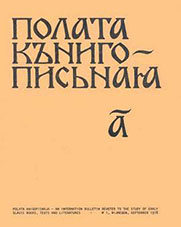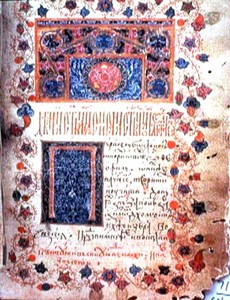The Hilandar Research Library has received the latest volume of Trudy Otdela Drevnerusskoi Literatury / ‘Works of the Department of Old Russian Literature,’ an invaluable publication of the Institute of Russian Literature “Pushkinskii Dom” of the Russian Academy of Sciences in St. Petersburg, Russia. The 774-page volume contains articles on the topics of biblical studies and the history of the Church; hagiography, hymnography, and tales of icons; historiography; didactic literature, polemical works, miscellanies; pilgrimage; scriptoria and scribes, archaeography; polemics; bibliography; and obituary notices of prominent scholars in the field.
Biblical Studies and the History of the Church
V.A. Romodanovskaia, “K istorii Novogo Zaveta Gennadievskoi biblii i Evangelii XV v. Razvitie sistem otsylok. Part II,” 3-20.
O.A. Belobrova, “Illiustrirovannye Biblii XVI-XVII vekov v russkikh srednevekovykh bibliotekakh,” 21-28.
G.M. Prokhorov, “Isihasty na Spaso-Kamennom,” 29-33.
N.V. Ponyrko, “Dimitrii Rostovskii kak avtor ‘Rozyska o raskol’nicheskoi brynskoi vere,” 34-42.
Hagiography, Hymnography, Tales of Icons
T.I. Aleksandrova, “Stikhiry sluzhby Velikogo pokaiannogo kanona Andreia Kritskogo i stanovlenie slavianskoi Triodi,” 43-52.
A.G. Mel’nik, “Praktika pochitaniia sv. Alekseia, mitropolita vseia Rusi, v XVI veke,” 53-69.
T.L. Nikitina, “Prepodobnyi Avraamii Rostovskii. Pozdniaia agiograficheskaia traditsiia i gimnografiia,” 70-92.
I.A. Lobakova, “Istoricheskie sobytiia i litsa v Zhitii Irinarkha Rostovskogo. Smutnoe vremia v agiograficheskom proizvedenii,” 93-119.
M.A. Fedotova, “Skazanie, koeia radi viny izlozhisia Akafist sviatiteliu Khristovu Dimitriiu,” (Ob odnom chude sviatogo Dimitriia Rostovskogo), 120-142.
V.V. Lepakhin, “Skazanie ob ikone Nikoly Zarazskogo. Nekotorye problemy issledovaniia,” 143-166.
E.M. IUkhimenko, “Vygovskaia ikona ‘Obraz vsekh rossiiskikh chudotvortsev,'” 167-174.
Historiography
E.G. Vodolazkin, “Kak sozdavalas’ Polnaia Khronograficheskaia Paleiia, Chast’ 2,” 175-200.
I.L. Zhukova, “Novyi spisok Sofiiskoi I letopisi (samostoiatel’naia gruppa),” 201-224.
A.V. Maiorov, “Grecheskii olovir Daniila Galitskogo. Iz kommentariia k Galitsko-Volynskoi letopisi,” 225-235.
E.S. Bystrova, “K probleme datirovki, Novgorodskoi Pogodinskoi letopisi,” 236-247.
A. S. Levochskaia, “O rabote IUriia Krizhanicha nad tekstom russkoi letopisi,” 248-259.
M.V. Semina, “Gramota velikogo kniazia Olega Riazanskogo XIV veka,” 260-268.
Didactic Literature, Polemical Works, Miscellanies
O.V. Tvorogov, “Opisanie sostava Prostrannoi redaktsii Prologa po spiskam XIV-XVI vekov, Chast’ 1: Prolog za sentiabr’-fevral’,” 269-342.
M.B. Pliukhanova, “‘Mnogoslozhnoe poslanie/svitok’ kak laboratoriia idei,” 375-419.
S.A. Semiachko, “‘Predanie starcheskoe novonachal’nomu inoku,’ v sostave Sledovannoi psaltiri,” 375-419.
Pilgrimage Literature
I.V. Fedorova, “Varvara Pavlovna Adrianova-Peretts kak issledovatel’ drevnerusskokh ‘khozhdenii’ (K 40-letiiu so dnia smerti),” 420-449.
I.V. Fedorova, “‘Povest’ o sviatoi gore Sinaiskoi’ – maloizvestnyi pamiatnik vostochnoslavianskoi palomicheskoi literatury,” 450-479.
Scriptoria and Scribes, Archaeography
M.A. Shibaev, “‘Vetshanye’ minei i rekonstruktsiia sbornikov XV v. iz biblioteki Kirillo-Belozerskogo monastyria,” 480-496.
T.R. Rudi, “K biografii Ermolaia-Erazma (Ermolai-Erazm i Kirillo-Belozerskii monastyr’),” 497-527.
A.G. Bobrov, “Proiskhozhdenie i sud’ba Musin-Pushkinskogo sbornika so ‘Slovom o polku Igoreve,'” 528-553.
O.V. Panchenko, “Povesti o solovetskikh pustynozhiteliakh (K istorii sozdaniia tsikla),” 554-613.
V.A. Esipova, “Dve rukopisi kruga Dimitriia Rostovskogo (Po materialam Nauchnoi biblioteki Tomskogo gosudarstvennogo universitets), 614-627.
A. Dzhurova, “Rol’ Vizantii v ofromlenii slavianskogo kodeksa (glagolicheskogo i kirillicheskogo): Problemy retseptsii,” 628-643.
E.A. Liakhovitskii, “Issledovanie bumagi v izuchenii pis’mennykh pamiatnikov. Problemy klassifikatsii i interpretatsii vodianykh znakov,” 644-672.
Polemics
L.V. Sokolova, “Pervonachal’na li Kratkaia redaktsiia ‘Zadonshchiny’? (V sviazi s noveishimi rabotami o vzaimootnoshenii ‘Slovo o polku Igoreve’ i ‘Zadoshchiny’),” 673-724.
Bibliography
Khronologicheskii spisok nauchnykh trudov Andreia Nikolaevicha Robinsona za 1946-2010 rr., 725-739.
Khronologicheskii spisok nauchnykh trudov Olega Viktorovicha Tvorogova za 2004-2014 rr., 740-744.
Khronologicheskii spisok nauchnykh trudov Natalii Sergeevny Demkovoi za 2002-2013 rr., 745-750.
Obituaries
Marina Alekseevna Salmina (1927-2013), 751-757
Elena Konstantinova Romodanovskaia (1937-2013), 758-763
List of abbreviations, 764-768
Submitting articles to TODRL, 769-771
Table of Contents, 772-774
 , which is vol. 4 of the series Studia Judaeoslavica, contains the collected proceedings from the Fifth Conference of the Enoch Seminar in Naples, Italy (June 14-18, 2009). It includes articles by Grant Macaskill, Liudmila Navtanovich, Anissava Miltenova et al.
, which is vol. 4 of the series Studia Judaeoslavica, contains the collected proceedings from the Fifth Conference of the Enoch Seminar in Naples, Italy (June 14-18, 2009). It includes articles by Grant Macaskill, Liudmila Navtanovich, Anissava Miltenova et al. Other works by Orlov include “Potaennye knigi”: iudeiskaia mistika v slavianskikh apokrifakh (2011), Dark Mirrors: Azazel and Satanael in Early Jewish Demonology (2011; Project MUSE 2014), Heavenly Priesthood in the Apocalypse of Abraham (2013), Selected Studies in the Slavonic Pseudepigrapha (2009), Divine Manifestations in the Slavonic Pseudepigrapha (2009), From Apocalypticism to Merkabah Mysticism: Studies in the Slavonic Pseudepigraph (2007), and The Enoch-Metatron Tradition (2005).
Other works by Orlov include “Potaennye knigi”: iudeiskaia mistika v slavianskikh apokrifakh (2011), Dark Mirrors: Azazel and Satanael in Early Jewish Demonology (2011; Project MUSE 2014), Heavenly Priesthood in the Apocalypse of Abraham (2013), Selected Studies in the Slavonic Pseudepigrapha (2009), Divine Manifestations in the Slavonic Pseudepigrapha (2009), From Apocalypticism to Merkabah Mysticism: Studies in the Slavonic Pseudepigraph (2007), and The Enoch-Metatron Tradition (2005).







